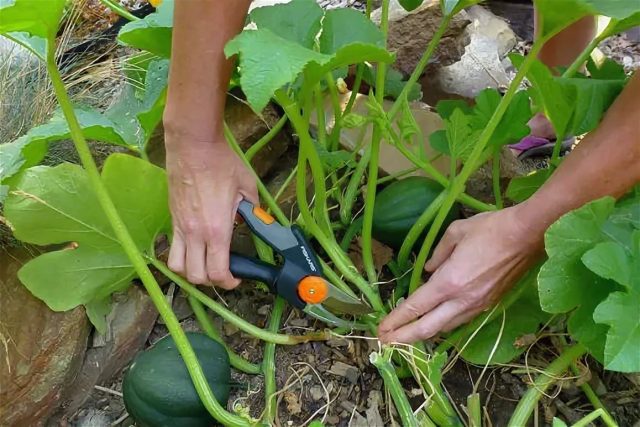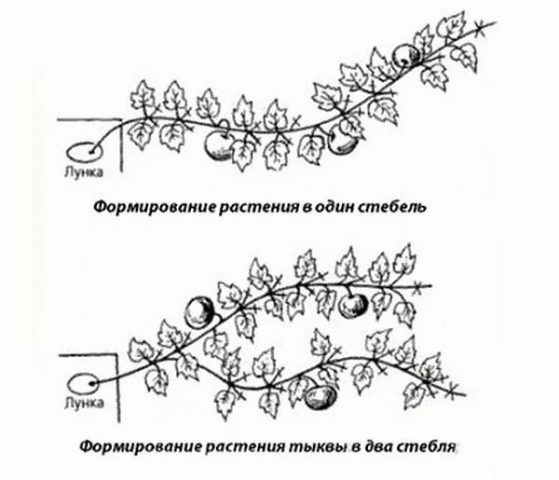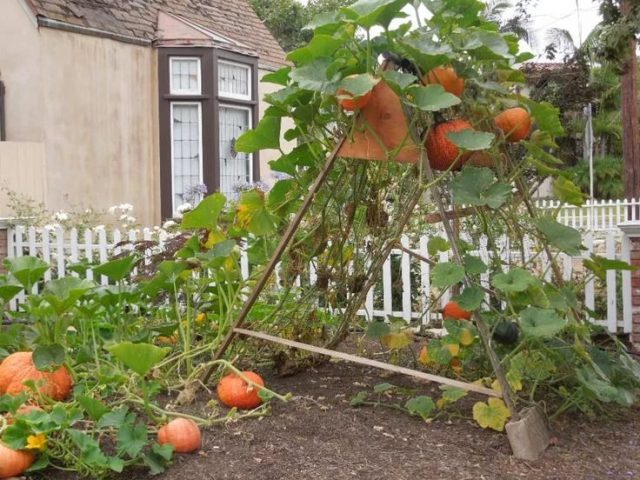Content
The pumpkin is grown in many regions of Russia. However, gardeners do not always pay due attention to such a care operation as pinching, or the formation of a bush. Meanwhile, it is necessary to form a pumpkin in the open field, such a procedure has a direct impact not only on the quantity, but also on the quality of the crop.
The Importance of Forming Pumpkin Outdoors
The uncontrolled growth of pumpkin usually leads to the fact that a rather large number of small fruits ripen on the bush, while the yield of marketable products leaves much to be desired. An option is also possible when fruiting does not occur at all. This situation is far from uncommon, especially in regions with a cool climate. This happens because the plant grows green mass throughout its life, expels many shoots, and forms a large number of fruit ovaries. In this case, for the laying and ripening of full-fledged fruits, it simply does not have enough nutrients.
The artificial formation of a pumpkin bush allows to correct the situation. In this case, the number of shoots is strictly normalized, and the required number of fruits is laid on the bush. It is on their maturation that the lion's share of the nutrients received by the plant will be spent. Thus, forming a bush, the gardener redirects nutrients to the ripening of fruits, while limiting their number and blocking the growth of green mass by the plant.
When to shape a pumpkin
Pinching is the removal of a portion of the stem above the set fruit. After such a procedure, all the juices that the plant would spend on the further growth of the shoot will go to the ripening of the fruit. You can start pinching pumpkin lashes after their length reaches at least 1 m. The procedure itself should be carried out in the early morning, before the onset of heat. If the day is cloudy, then work can be done throughout the day.
How to pinch a pumpkin outdoors, depending on the variety and type
Pumpkins are distinguished by a wide variety of varieties and types. There are three main groups of these plants:
- Decorative... Such pumpkins have a beautiful appearance and are used to decorate household plots, as well as ornamental materials and souvenirs.
- Fodder... Grown for feeding to pets.
- Canteens... These types of pumpkins are used for food.
In addition, pumpkins are subdivided depending on the ripening time, the size of the fruit, the length of the lashes and some other factors.
Formation of a bush in 1,2 and 3 stems
Ornamental and forage pumpkin varieties are usually not pinched, since in this case size and taste do not matter. When forming table varieties, the formation is carried out in 1,2 or 3 stems, depending on the yield of the variety, soil fertility and the climate of the region. In the most unfavorable conditions, with insufficient soil nutrition and a cool climate, the plant is formed into 1 stem. To do this, leave 2 fruits on the main lash, pinch the stem at a distance of 4-5 leaves above the extreme fruit.
In more favorable conditions, you can form a pumpkin in 2 stems (main lash + side) or 3 (main + 2 side).In this case, an additional 1 fruit is left on each of the side shoots. Above it, at a distance of 5 leaves, the stem is pinched.
The scheme of pumpkin formation in the open field is shown in the figure below.
How to pinch a bush pumpkin in the open field
Bush pumpkin varieties do not form long lashes, so many gardeners grow such varieties in order to save space on the site. However, such species also need to be pinched. Otherwise, the bush will form a large number of empty shoots. The harvest must also be normalized, otherwise it will be small-fruited and tasteless. 3-4 ovaries are usually left per bush. All other flowers are removed, as well as excess lateral shoots.
A video about pinching a pumpkin and how to form it to get a good harvest can be viewed at the link below.
Pinching a climbing gourd outdoors
The pumpkin is characterized by intensive growth and significant stem sizes, therefore, a lot of space is needed to grow them in the open field. In a crowded planting, the stems are often intertwined, which creates additional difficulties. When grown in a creeping form, you can form a melon in 1.2 or 3 stems, it all depends on the climate of the region and the fertility of the land. The worse the conditions, the fewer shoots and ovaries need to be left.
Climbing pumpkins are pinched after the size of the fruit ovaries exceeds 10 cm. The stems are straightened so that they are directed to the south. The pumpkin is very fond of light and warmth, this orientation will allow the bush to receive more sunlight.
Climbing pumpkin can be grown both in creeping and in bush form, using natural or artificial supports: fences, nets, walls. The plant is perfectly kept on them with antennae. With this method of cultivation, two shoots are usually formed, the main one and the side, spreading them in opposite directions. At the same time, the general principle of formation remains unchanged. On the main lash, 2-3 fruit ovaries are left, on the side - 1. Having departed 4-6 leaves from them, they pinch.
After pinching, the plant will continue to strive to build up green mass, constantly releasing side shoots - stepchildren. They must be completely removed immediately.
Another video on how to pinch a pumpkin correctly when growing outdoors:
Crop care after pinching
After removing part of the shoot, fresh sections are usually not processed, they dry out on their own. You can also dust them with earth to minimize moisture loss. In order for the plant to receive additional nutrition, the internodes of the lashes are sprinkled with soil. This not only fixes the plant on the ground and prevents it from moving along the garden bed under the influence of the wind, in such places the stem takes root. Under each fruit lying on the ground, you must put a piece of foam or a board, thereby limiting its contact with the ground.
After the formation of the pumpkin bush, you should continue all the usual care operations: watering, weeding, feeding.
A few tips for novice gardeners
Pinching a pumpkin in the open field is a very important event. To get a high-quality harvest, you cannot do without this procedure. Here are some tips for novice gardeners to help you avoid mistakes in the work.
- All work on the formation of a pumpkin can only be started after the fruits of the size of a fist have formed on it.
- Pinching significantly shortens the ripening period of the fruit.This is very important when growing pumpkins in the northern regions. In order for a short summer to be enough for full ripening, in such regions the plant is formed into 1 stem, leaving 1-2 fruits on it. It is also possible to shorten the ripening period of the crop by using the seedling method of growing, when not seeds are planted in open ground, but a plant that has already started to grow.
- For areas with unfavorable climates, it is better to choose bush or weakly branching varieties of early ripening.
- There is no need to chase quantity. Even in the southern fertile regions, only 3-5 pumpkins on a bush fully ripen, the rest are small, immature and tasteless.
- It is best to pinch early in the morning. Then the slices will have time to dry before the end of the day.
- Some gardeners leave 1-2 fruit ovaries "in reserve". They will come in handy in case of death or damage to the main fruit. And you can cut them off at any time.
- There is no need to be afraid to bury the whips or sprinkle them with earth, fixing them in the garden. They will take much more damage if intertwined with each other, and then they will have to be unraveled.
- Stepsons, extra shoots, unnecessary flowers should be continued to be cut off until the time of harvest, so that they do not pull off some of the nutrients.
- Growing a pumpkin on a grid or a support can significantly reduce the pumpkin footprint. It is much more convenient to pinch such plants, since all the lashes are in plain sight.
- The nets in which the ripening pumpkins are suspended must be periodically turned so that the fruits are illuminated by the sun evenly from all sides. This helps to improve their taste.
- Young shoots and stepchildren are usually removed simply by hand. To cut a large shoot, it is more convenient to use a regular garden pruner.
Conclusion
Forming a pumpkin outdoors is quite simple. Many gardeners forget about the need to do this, relying on the fact that the pumpkin itself will regulate the number of fruits and give a good harvest. However, this only happens in the southern regions, where the long summer allows the fruits to ripen completely in natural conditions. In an unfavorable climate, it is unlikely to get a good harvest without pinching.











